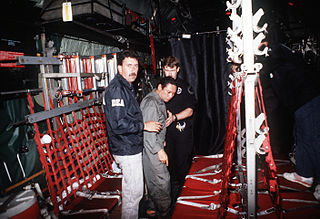
The Lockheed AC-130 gunship is a heavily armed, long-endurance, ground-attack variant of the C-130 Hercules transport, fixed-wing aircraft. It carries a wide array of ground-attack weapons that are integrated with sophisticated sensors, navigation, and fire-control systems. Unlike other modern military fixed-wing aircraft, the AC-130 relies on visual targeting. Because its large profile and low operating altitudes around 7,000 feet make it an easy target, its close air support missions are usually flown at night.

The United States invasion of Grenada began at dawn on 25 October 1983. The U.S. and a coalition of six Caribbean nations invaded the island nation of Grenada, 100 miles (160 km) north of Venezuela. Codenamed Operation Urgent Fury by the U.S. military, it resulted in military occupation within a few days. It was triggered by the strife within the People's Revolutionary Government which resulted in the house arrest and execution of the previous leader and second Prime Minister of Grenada Maurice Bishop, and the establishment of the Revolutionary Military Council with Hudson Austin as Chairman. The invasion resulted in the appointment of an interim government, followed by elections in 1984.

Bagram Airfield-BAF also known as Bagram Air Base is an Afghan military base, and formerly the largest U.S. military base in Afghanistan. It is located next to the ancient city of Bagram, 11 kilometres (6.8 mi) southeast of Charikar in the Parwan Province of Afghanistan. It has a single runway capable of handling large military aircraft, including the Lockheed Martin C-5 Galaxy and Antonov An-225. It was staffed by the 455th Air Expeditionary Wing of the U.S. Air Force, along with rotating units of the U.S. and coalition forces.

The United States Invasion of Panama, codenamed Operation Just Cause, lasted over a month between mid-December 1989 and late January 1990. It occurred during the administration of President George H. W. Bush and ten years after the Torrijos–Carter Treaties were ratified to transfer control of the Panama Canal from the U.S. to Panama by January 1, 2000. The primary purpose of the invasion was to depose the de facto Panamanian leader, general and dictator Manuel Noriega. He was wanted by the United States for racketeering and drug trafficking. Following the operation, the Panama Defense Forces were dissolved and President-elect Guillermo Endara was sworn into office. The United Nations General Assembly and the Organization of American States condemned the invasion as a violation of international law.

A gunship is a military aircraft armed with heavy aircraft guns, primarily intended for attacking ground targets either as airstrike or as close air support.

The 75th Ranger Regiment, also known as Army Rangers, is the U.S. Army's elite premier light infantry unit and special operations force within the United States Army Special Operations Command. The regiment is headquartered at Fort Benning, Georgia and is composed of a regimental headquarters company, a military intelligence battalion, a special troops battalion, and three Ranger battalions.

The Lockheed MC-130 is the basic designation for a family of special mission aircraft operated by the United States Air Force Special Operations Command (AFSOC), a wing of the Air Education and Training Command, and an AFSOC-gained wing of the Air Force Reserve Command. Based on the Lockheed C-130 Hercules transport, the MC-130s' missions are the infiltration, exfiltration, and resupply of special operations forces, and the air refueling of (primarily) special operations helicopter and tilt-rotor aircraft.

Task Force 20 is a temporary combat force designation that has been used several times and may still used by separate parts of the United States armed forces. The longer-established iteration was a part of the United States Second Fleet in the Atlantic from after the Second World War. This was part of the formal United States Military Communications-Electronic Board system.

The Boeing MH-6M Little Bird and its attack variant, the AH-6, are light helicopters used for special operations in the United States Army. Originally based on a modified OH-6A, it was later based on the MD 500E, with a single five-bladed main rotor. The newest version, the MH-6M, is based on the MD 530F and has a single, six-bladed main rotor and four-bladed tail rotor.

Operation Nifty Package was a United States Delta and Navy SEAL-operated plan conducted in 1989 designed to capture Panamanian leader Manuel Noriega. When Noriega took refuge in the Apostolic Nunciature of the Holy See, deafening music and other psychological warfare tactics were used to convince him to exit and surrender himself.

The 2nd Ranger Battalion, currently based at Joint Base Lewis–McChord south of Seattle, Washington, United States, is the second of three ranger battalions belonging to the United States Army's 75th Ranger Regiment.

The 3rd Ranger Battalion, currently based at Fort Benning, Georgia, is the third of three Ranger Battalions belonging to the United States Army's 75th Ranger Regiment.

The Battle of Kham Duc was a major battle of the Vietnam War. The event occurred in Khâm Đức, now district capital of Khâm Đức District, then in Quảng Tín Province, from 10–12 May 1968. During the Tet Offensive of 1968, the People's Army of Vietnam (PAVN) 2nd Division tried to capture Đà Nẵng, but they were defeated in the Battle of Lo Giang by elements of the U.S. 1st Marine Division and the 23rd Infantry Division (Americal). PAVN General Chu Huy Mân disengaged from the fight on the outskirts of the city, and pulled the 2nd Division into the mountains where it could rest, rebuild, and prepare for the next major operation. Khâm Đức, a small district in the north of Quảng Tín, was chosen as the next target for the 2nd Division. Following their defeat at Đà Nẵng, U.S. military intelligence agencies in I Corps Tactical Zone were confused by the movements of the 2nd Division, because they could not track down the unit.

The 415th Special Operations Squadron is a United States Air Force unit. It is assigned to the 58th Operations Group at Kirtland Air Force Base, New Mexico.

The 16th Special Operations Squadron is part of the 27th Special Operations Wing at Cannon Air Force Base, New Mexico. It operates the AC-130W Stinger II aircraft in support of special operations.

Scarlett Martínez International Airport, also known as Río Hato Airport, is an international airport serving Río Hato, a town in the Coclé Province of Panama. The airport is 3 kilometres (2 mi) east of Río Hato.
The Capture of Torrijos Airport was a U.S military operation during the invasion of Panama. The goal of this operation was to capture the Panamanian air force, headquartered at the airport, and to close the airport to traffic coming into Panama.
The Battles of Nakhang were fought between Royalist forces and North Vietnamese invaders for control of the northern base of Nakhang, Laos. The Lima Site 36 airstrip at Nakhang was capable of handling aircraft up to the size of C-123 cargo carriers; its location and length made it a vital component of the Royalist defense. Lima Site 36 was the airhead for their guerrillas' movements and resupply, as well as a staging point for U.S. combat search and rescue helicopters.
The Battle of Paitilla Airport was a battle between members of the Panama Defense Force and SEAL Team 4, on the 20th of December 1989, in the starting hours of Operation Just Cause. The force consisted of forty-eight U.S. Navy SEALs under the command of Lt. Cmdr. Patrick Toohey. The team was tasked with destroying Manuel Noriega's private jet on the ground at the Punta Paitilla Airport, in Panama City.

The 7th Macho de Monte Infantry Company was an elite infantry battalion of the Panama Defense Forces. Its mascot was the Baird's tapir, from which the company took it name, as in Panama the tapir is called 'Macho de Monte' which translates as 'mountain men'. It was based at the Base Militar "General de Division Omar Torrijos Herrera" in Rio Hato and specialised in guerrilla warfare.

















